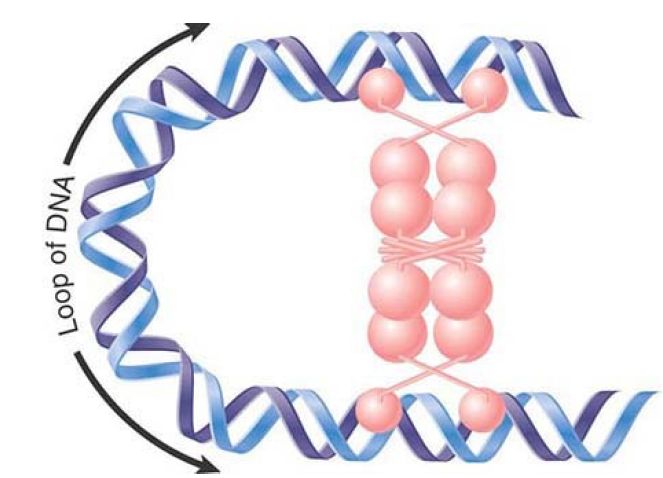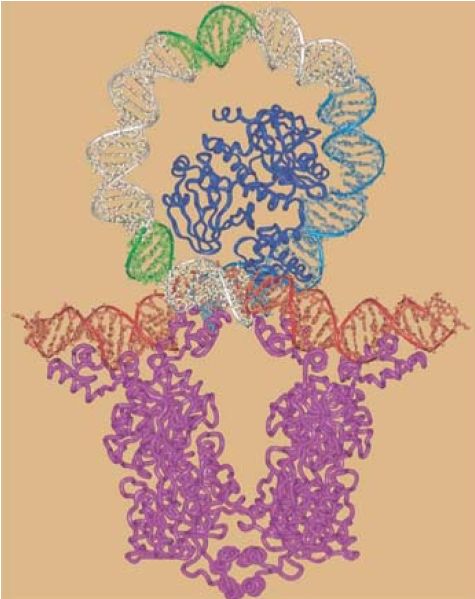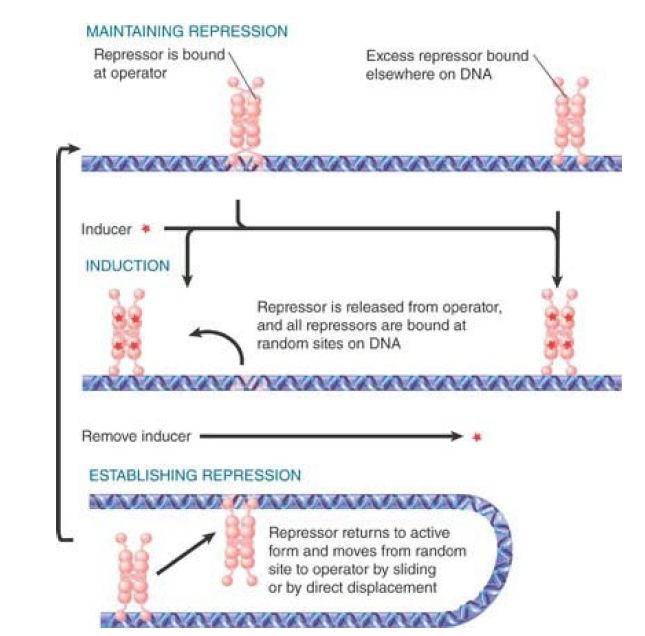


 النبات
النبات
 الحيوان
الحيوان
 الأحياء المجهرية
الأحياء المجهرية
 علم الأمراض
علم الأمراض
 التقانة الإحيائية
التقانة الإحيائية
 التقنية الحيوية المكروبية
التقنية الحيوية المكروبية
 التقنية الحياتية النانوية
التقنية الحياتية النانوية
 علم الأجنة
علم الأجنة
 الأحياء الجزيئي
الأحياء الجزيئي
 علم وظائف الأعضاء
علم وظائف الأعضاء
 الغدد
الغدد
 المضادات الحيوية
المضادات الحيوية| The lac Repressor Binds to Three Operators and Interacts with RNA Polymerase |
|
|
|
Read More
Date: 20-12-2015
Date: 29-12-2015
Date: 31-10-2020
|
The lac Repressor Binds to Three Operators and Interacts with RNA Polymerase
KEY CONCEPTS
- Each dimer in a repressor tetramer can bind an operator; thus, the tetramer can bind two operators simultaneously.
- Full repression requires the repressor to bind to an additional operator downstream or upstream, as well as to the primary operator at the lacZ promoter.
- Binding of repressor at the operator stimulates binding of RNA polymerase at the promoter but precludes transcription.
The repressor dimer is sufficient to bind the entire operator sequence. Why, then, is a tetramer required to establish full repression?
Each dimer can bind an operator sequence. This enables the intact tetrameric repressor to bind to two operator sites simultaneously. In fact, the initial region of the lac operon has two additional operator sites. The original operator, O1, is located just at the start of the lacZ gene. It has the strongest affinity for repressor. Weaker operator sequences are located on either side; O2 is 410 bp downstream of the start point in lacZ and O3 is 88 bp upstream of lacO1, within the lacI gene.
FIGURE 1. predicts what happens when a DNA-binding protein simultaneously binds to two separated sites on DNA. The DNA between the two sites forms a loop from a base where the protein has bound the two sites. The length of the loop depends on the distance between the two binding sites. When the lac repressor binds simultaneously to O1 and to one of the other operators, it causes the DNA between them to form a rather short loop, significantly constraining the DNA structure. A scale model for binding of tetrameric repressor to two operators is shown in FIGURE 2. Low-resolution, looped complexes have been directly visualized with single-molecule experiments.

FIGURE 1. If both dimers in a repressor tetramer bind to DNA, the DNA between the two binding sites is held in a loop.

FIGURE 2. When a repressor tetramer binds to two operators, the stretch of DNA between them is forced into a tight loop. (The blue structure in the center of the looped DNA represents CRP, which is another regulator protein that binds in this region.)
Reproduced from M. Lewis et al., Science 271 (1996): 1247–1254
[http://www.sciencemag.org]. Reprinted with permission from AAAS. Photo courtesy of
Ponzy Lu, University of Pennsylvania.
Binding at the additional operators affects the level of repression. Elimination of either the downstream operator (O2) or the upstream operator (O3) reduces the efficiency of repression by two to four times. If, however, both O2 and O3 are eliminated, repression is reduced more than 50 times. This suggests that the ability of the repressor to bind to one of the two other operators, as well as to O1, is important for establishing strong repression.
In vitro experiments with supercoiled plasmids containing multiple operators demonstrate significant stabilization of the LacI–DNA complex. Nonetheless, these looped DNAs are released rapidly when the lac repressor binds to IPTG.
Several lines of evidence suggest how binding of the repressor to the operator (O1) inhibits transcription initiation by polymerase. It was originally thought that repressor binding would occlude RNA polymerase from binding to the promoter. It is now known that the two proteins may be bound to DNA simultaneously, and that, surprisingly, the binding of the repressor actually enhances the binding of RNA polymerase. The bound enzyme is prevented from initiating transcription, though. The repressor, in effect, causes RNA polymerase to be stored at the promoter. When the inducer is added, the repressor is released, and RNA polymerase can initiate transcription immediately. The overall effect of the repressor is to speed up the induction process.
Does this model apply to other systems? The interaction between RNA polymerase, the repressor, and the promoter/operator region is distinct in each system, because the operator does not always overlap with the same region of the promoter (this can be seen later in Figure 3). For example, in phage lambda, the operator lies in the upstream region of the promoter, and binding of the lambda repressor occludes the binding of RNA polymerase (see the Phage Strategies chapter). Thus, a bound repressor does not interact with RNA polymerase in the same way in all systems.

FIGURE 3. Virtually all the repressor in the cell is bound to DNA.



|
|
|
|
تفوقت في الاختبار على الجميع.. فاكهة "خارقة" في عالم التغذية
|
|
|
|
|
|
|
أمين عام أوبك: النفط الخام والغاز الطبيعي "هبة من الله"
|
|
|
|
|
|
|
قسم شؤون المعارف ينظم دورة عن آليات عمل الفهارس الفنية للموسوعات والكتب لملاكاته
|
|
|